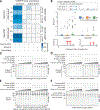Functionally diverse type V CRISPR-Cas systems
- PMID: 30523077
- PMCID: PMC11258546
- DOI: 10.1126/science.aav7271
Functionally diverse type V CRISPR-Cas systems
Abstract
Type V CRISPR-Cas systems are distinguished by a single RNA-guided RuvC domain-containing effector, Cas12. Although effectors of subtypes V-A (Cas12a) and V-B (Cas12b) have been studied in detail, the distinct domain architectures and diverged RuvC sequences of uncharacterized Cas12 proteins suggest unexplored functional diversity. Here, we identify and characterize Cas12c, -g, -h, and -i. Cas12c, -h, and -i demonstrate RNA-guided double-stranded DNA (dsDNA) interference activity. Cas12i exhibits markedly different efficiencies of CRISPR RNA spacer complementary and noncomplementary strand cleavage resulting in predominant dsDNA nicking. Cas12g is an RNA-guided ribonuclease (RNase) with collateral RNase and single-strand DNase activities. Our study reveals the functional diversity emerging along different routes of type V CRISPR-Cas evolution and expands the CRISPR toolbox.
Copyright © 2019 The Authors, some rights reserved; exclusive licensee American Association for the Advancement of Science. No claim to original U.S. Government Works.
Figures




Comment in
-
Stirring Up the Type V Alphabet Soup.CRISPR J. 2019 Feb;2:14-16. doi: 10.1089/crispr.2019.29044.dcs. CRISPR J. 2019. PMID: 31021231 No abstract available.
References
Publication types
MeSH terms
Substances
Grants and funding
LinkOut - more resources
Full Text Sources
Other Literature Sources
Research Materials

